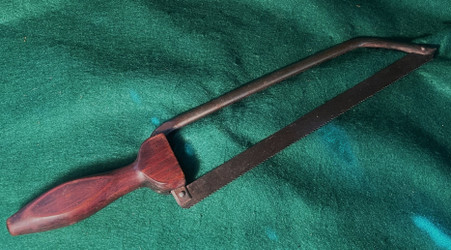 Loading... Please wait...
Loading... Please wait...-
Call us on (973) 810-2976
- My Account
- Gift Certificates
- Items / $0.00
All prices are in All prices are in USD
Categories
- Home
- Medical Related Items
- RARE – Government issue marked Civil War Surgeon’s Amputation saw
- Home
- Identified Artifacts
- RARE – Government issue marked Civil War Surgeon’s Amputation saw
- Home
- Non-excavated Artifacts
- RARE – Government issue marked Civil War Surgeon’s Amputation saw
- Home
- Personal Items
- RARE – Government issue marked Civil War Surgeon’s Amputation saw
RARE – Government issue marked Civil War Surgeon’s Amputation saw
Product Description
This is another nice piece being offered from a Civil War collection I recently acquired - it is a Civil War Surgeon’s Amputation Saw. The overall measurement is 16 ¾” x 3 ½”. What is rare is that it is marked on the wooden handle is “U.S. / M D”, which stands for the United States Medical Department – making it government issued. Also stamped on the metal is what appears to be “JACKSON 5 CAST-STEEL”, who probably had a contract with the government.
Over the course of the Civil War, an estimated 476,000 soldiers were wounded by bullets, artillery shrapnel, or sabers and bayonets. The most common wounds suffered by Civil War soldiers were from the bullets fired by muskets. The typical bullet fired was called a Minnie ball, a conical bullet with hollowed grooves. Weighting 1 ½ ounces the large bullets (.58 caliber) were propelled relatively slowly by the black power charge.
When it struck a human, the ball caused considerable damage, oftentimes flattening upon impact. Minnie balls splintered bones, damaged muscle, and drove dirt, clothing, and other debris into the wounds. As a result of the immense damage inflicted by Minnie balls, amputations were common during the Civil War.
After the Battle of Fredericksburg, the poet Walt Whitman described the scene at a Federal hospital at Chatham just across the Rappahannock River:
“It is used as a hospital since the battle and seems to have received only the worst cases. Outdoors, at the foot of a tree, within ten yards of the front of the house, I noticed a heap of amputated feet, legs, arms, hands, etc. -- about a load for a one-horse cart. Several dead bodies lie near; each covered with its brown woolen blanket. In the dooryard, toward the river, are fresh graves, mostly of officers, their names on pieces of barrel staves or broken board, stuck in the dirt.”
An amputation is a surgical procedure that removes a piece of the body because of trauma or infection. Over the course of the Civil War, three out of four surgeries (or close to 60,000 operations) were amputations. This earned surgeons throughout the armies a reputation of being “butchers” when in fact amputations were one of the quickest, most effective ways for surgeons to treat as many patients as possible in a short amount of time.
I had amputation saws in the past, but this is the nicest one I had, and the only government-issued example. In a period photograph of a Civil War amputation, the surgeon is using one of these saws (see pictures).



